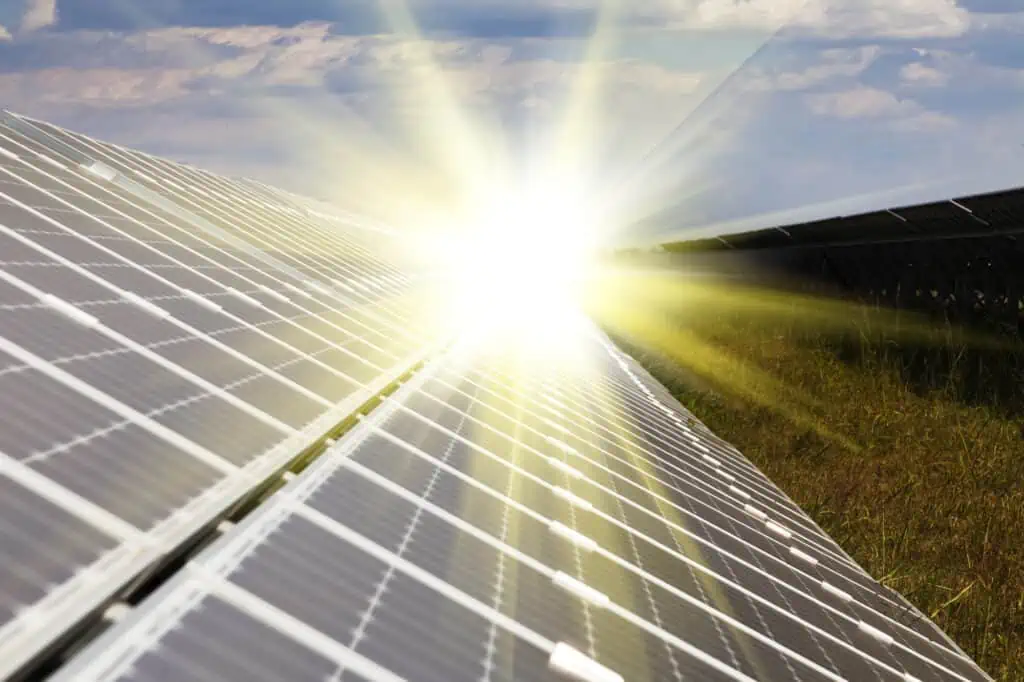Ever stepped outside on a beautiful sunny day and felt the warmth spread across your face? Or squinted as the sunlight danced off every reflective surface?
Have you ever wondered if all that bright, glorious sunshine could be doing something more… well, useful? Like, say, powering your home?
Guess what? With the help of solar panels, it can!
Welcome to the renewable energy revolution, where every sunbeam has the potential to power your coffee maker, charge your phone, or even cool your home on a hot day.
So, buckle up, sunshine! You’re about to embark on a fascinating journey into solar energy.
This guide will provide you with the answer to this shining question: Exactly how much solar power can I generate with my own mini-power station?
Spoiler alert: It’s probably more than you think!
Contents
Determining the Solar Potential of Your Location
To start with, you need to think about your geographic location. Just as real estate is all about location, so is the output of your solar panel systems.
Why? It’s all about the amount of sunlight, or ‘solar irradiance’, available in your area.
Importance of Geographic Location in Solar Power Generation
Locations near the equator usually get more sunlight than areas towards the poles. But it’s not all about latitude. Local weather patterns, cloud cover, and altitude can also affect the solar panel output.
How To Assess Solar Irradiance and Sun Hours in Your Location
In solar speak, ‘sun hours’ are the number of hours per day when solar irradiance exceeds a given level.
This isn’t the same as daylight hours. Even on the longest day of the year, there aren’t 24 sun hours!
Online solar irradiance maps or tools can help you assess your location’s solar potential. You could also consult a local solar installer for more precise data.
Components of a Solar Power System
Understanding the main components of a solar power system is crucial to comprehend your energy production. After all, your solar array is more than just a collection of solar panels on the roof.
Understanding Solar Panels
There are various types of solar panels. This includes:
- Monocrystalline panels
- Polycrystalline panels
- Thin-film panels
Each type has different efficiency rates. This means that they convert a different percentage of sunlight into electricity.
When evaluating the potential solar energy output of a panel, the efficiency of the solar panel is a crucial factor to consider.
Role and Importance of the Solar Inverter
Time for a little solar power trivia: Did you know that the power created by solar panels isn’t immediately ready to use in your home?
That’s where the solar inverter comes in.
This vital device takes the DC (direct current) electricity that your solar panels produce and flips it into AC (alternating current) electricity that your home’s appliances can use.
And if your solar array is generating more power than you need? The inverter helps feed that excess power back into the electrical grid.
Without an inverter, your solar panels would be sunbathing beauties without any real job.
Understanding Other Components
A solar panel system has additional components that, while less recognized, play crucial roles in your overall solar power production.
- Battery storage systems: These let you save the electricity your solar panels generate so you can use it when the sun isn’t shining—like at night or during a stormy day.
- Charge controllers: These protect your battery from being overcharged by regulating the voltage and current from your solar panels.
- Mounting systems: These keep your solar panels securely attached to your roof or ground. The right mount can even help angle your panels for optimal sunlight exposure.
Calculating Your Energy Consumption
Understanding how much electricity you use is a crucial first step before calculating how much solar power you can generate.
Knowing your usage can help determine the size of the solar panel system you’ll need to offset your energy costs effectively.
How To Calculate Your Daily and Annual Energy Consumption
If you’re unsure about your energy consumption, your utility bill is the best place to start. Utility companies usually express your consumption in terms of kilowatt-hours (kWh).
To determine your annual consumption, you’ll want to add up the kWh each month. This will give you a full year’s snapshot of your electricity usage.
Now, to figure out your daily energy consumption, take that annual total and divide it by 365 (or 366 if it’s a leap year!).
This daily figure is an excellent benchmark for understanding how much electricity you need to generate to meet or exceed your energy demands.
Understanding the Power Rating of Common Home Appliances
Every electrical device in your home, from your hairdryer to your refrigerator, comes with a ‘power rating.’
This figure, typically measured in watts (W), tells you how much electricity each device uses when it’s switched on.
But power ratings alone can’t tell you your total energy consumption. After all, you don’t use every device simultaneously. And some devices are on longer than others.
To get a more accurate picture of your daily energy usage, do the following:
- Make a list. List all your electrical devices, their power ratings, and how long you typically use them daily.
- Multiply the power rating by the hours of use. This allows you to get the energy consumption in watt-hours (or kWh if you divide by 1,000).
- Add up all these amounts. Then, you’ll have a solid estimate of your daily energy usage.
Identifying Peak Power Demands
It’s also important to understand that energy consumption isn’t consistent throughout the day.
Certain times tend to see spikes in usage. Some examples are early evenings when people return from work or school or hot summer afternoons when air conditioning units are working overtime.
Identifying these peak power demand times is crucial when you’re considering a solar panel system.
Solar panels produce energy only during daylight hours. Unless you have a battery storage system, you’ll need to use the electricity as it’s generated.
By understanding your peak power demands, you can better size your solar panel system to meet these demands. You can also consider options for battery storage to use solar-generated electricity later in the day.
How to Calculate Solar Power Generation
Are you ready to take the plunge and do some math?
Don’t worry! It’s not as hard as it sounds, and this part is pretty exciting.
It’s here where we start figuring out the amount of solar power you could generate.
Explanation of Terms: Watt, Kilowatt, Kilowatt-hour
Before we start, let’s get familiar with some basic terms.
‘Watt’ (W) is a unit of power that measures how much energy can be produced or consumed at a given moment.
‘Kilowatt’ (kW) is 1,000 watts.
Now, ‘kilowatt-hour’ (kWh) might sound a bit complex, but it’s simply a measure of energy that represents the electricity you’re using if you keep a 1,000-watt appliance running for an hour.
It’s the term energy companies use when charging you for energy consumption.
The Formula and the Step-by-Step Process
With these terms under our belt, we can move on to the main event: figuring out how much power your solar panels might generate.
Here’s the formula you’ll need:
Solar Panel Wattage x Sun Hours x Solar Panel Efficiency = Daily Output in kWh
It’s as simple as that!
Plug in your panel’s wattage, the number of hours of sun your location gets, and your panel’s efficiency rate. And voila–you have an estimate of how much electricity your solar panels can produce each day!
How To Account for System Losses
Keep in mind that no system operates at 100% efficiency. There will always be some energy loss due to a variety of factors.
Solar inverters, for instance, have an efficiency rating that tells you how much energy is lost when converting solar-generated electricity from DC to AC.
Other potential losses can occur due to the following:
- Dust or dirt accumulation on the panels
- Shading issues
- The angle and orientation of your solar panels
So, in your calculations, you might want to factor in a certain loss percentage to get a more accurate estimation.
How Much Can You Generate?
Applying The Solar Power Generation Formula
So, let’s say you have ten solar panels, each with a 300-watt power output rating. And you live in an area with about five hours of sunlight at ideal conditions for solar panels each day.
If we assume a system efficiency of 80%, you might get the following:
300W x 10 panels x 5 hours x 0.8 = 12,000 watt-hours = 12 kWh per day
If your household uses less than 12 kWh per day, congrats! In ideal conditions, you could be ‘net-zero’—that’s a solar dream come true!
But this calculation is a simplified illustration.
Your output may differ due to weather conditions, the angle and orientation of your panels (south-facing roofs are best in the Northern Hemisphere), and other factors.
Factors Affecting Solar Power Generation
Impact of Weather Conditions and Seasonal Variations
No surprise here, but the amount of direct sunlight your panels receive can be influenced by weather conditions such as cloud cover, rain, or snow.
Likewise, the sun’s changing path throughout the year means solar output can ebb and flow with the seasons.
Effect of Shading, Panel Angle, and Orientation on Solar Power Generation
The ideal setup has panels facing towards the equator at an angle similar to your latitude. But don’t worry if that’s impossible—panels can still generate much electricity in less-than-ideal conditions.
Role of System Efficiency and Maintenance
Regular maintenance of your solar panels can ensure your system keeps operating at its best. This includes cleaning and checks by a professional solar installer.
Summing It Up
And there you have it—your comprehensive guide to calculating your potential solar energy production!
But remember, this guide is just a starting point. Consider contacting a professional solar installer for the most accurate prediction tailored to your unique home and lifestyle.
And while crunching numbers and understanding the mechanics is crucial, the ultimate goal is to harness the sun’s power, reduce electricity costs, and contribute to a healthier planet.
Solar power isn’t just about kilowatts and power output ratings. It’s about embracing a sustainable, environmentally friendly lifestyle.
So, get out there, bask in the sun, and let your solar panels soak up those golden rays! After all, every day is a sunny day when you’re producing your renewable energy.
Connect with Solar Comparison
If this guide has sparked your interest, or you’re left with more questions, don’t worry! We’re here to keep the conversation going.
At Solar Comparison, we’re passionate about making solar energy accessible and understandable for everyone.
Check out our other blogs! We’ve got articles ranging from the basics of solar energy to the latest advancements in solar technology.
It’s all part of our mission to keep you informed and excited about solar power.
You can also try our solar calculator! It’s user-friendly and designed to give you a more accurate projection of your potential energy production based on your circumstances.
Got a burning question? Or a topic you want us to cover? Feel free to contact us! We’d love to hear from you and continue to support your solar journey.




